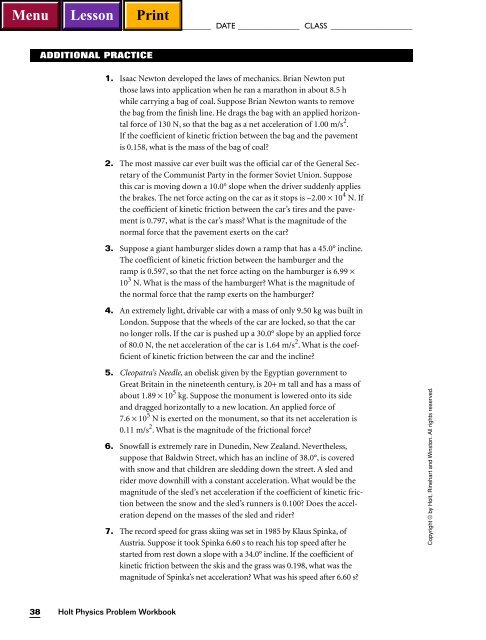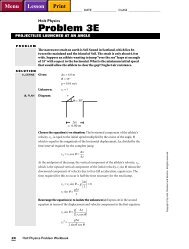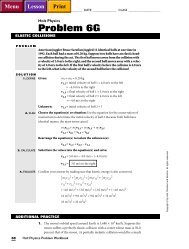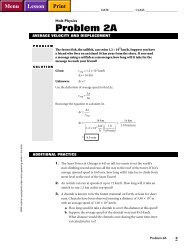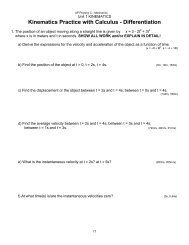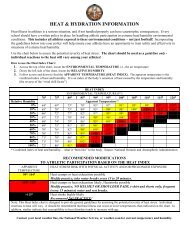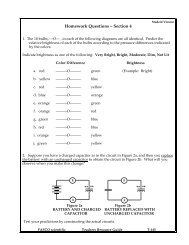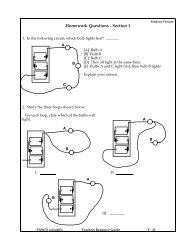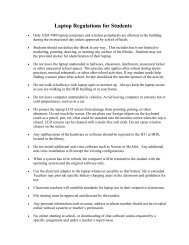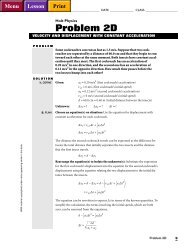Holt Physics Problem 4D - Hays High School
Holt Physics Problem 4D - Hays High School
Holt Physics Problem 4D - Hays High School
Create successful ePaper yourself
Turn your PDF publications into a flip-book with our unique Google optimized e-Paper software.
NAME ______________________________________ DATE _______________ CLASS ____________________<br />
38<br />
ADDITIONAL PRACTICE<br />
1. Isaac Newton developed the laws of mechanics. Brian Newton put<br />
those laws into application when he ran a marathon in about 8.5 h<br />
while carrying a bag of coal. Suppose Brian Newton wants to remove<br />
the bag from the finish line. He drags the bag with an applied horizontal<br />
force of 130 N, so that the bag as a net acceleration of 1.00 m/s 2 .<br />
If the coefficient of kinetic friction between the bag and the pavement<br />
is 0.158, what is the mass of the bag of coal?<br />
2. The most massive car ever built was the official car of the General Secretary<br />
of the Communist Party in the former Soviet Union. Suppose<br />
this car is moving down a 10.0° slope when the driver suddenly applies<br />
the brakes. The net force acting on the car as it stops is –2.00 × 10 4 N. If<br />
the coefficient of kinetic friction between the car’s tires and the pavement<br />
is 0.797, what is the car’s mass? What is the magnitude of the<br />
normal force that the pavement exerts on the car?<br />
3. Suppose a giant hamburger slides down a ramp that has a 45.0° incline.<br />
The coefficient of kinetic friction between the hamburger and the<br />
ramp is 0.597, so that the net force acting on the hamburger is 6.99 ×<br />
10 3 N. What is the mass of the hamburger? What is the magnitude of<br />
the normal force that the ramp exerts on the hamburger?<br />
4. An extremely light, drivable car with a mass of only 9.50 kg was built in<br />
London. Suppose that the wheels of the car are locked, so that the car<br />
no longer rolls. If the car is pushed up a 30.0° slope by an applied force<br />
of 80.0 N, the net acceleration of the car is 1.64 m/s 2 . What is the coefficient<br />
of kinetic friction between the car and the incline?<br />
5. Cleopatra’s Needle, an obelisk given by the Egyptian government to<br />
Great Britain in the nineteenth century, is 20+ m tall and has a mass of<br />
about 1.89 × 10 5 kg. Suppose the monument is lowered onto its side<br />
and dragged horizontally to a new location. An applied force of<br />
7.6 × 10 5 N is exerted on the monument, so that its net acceleration is<br />
0.11 m/s 2 . What is the magnitude of the frictional force?<br />
6. Snowfall is extremely rare in Dunedin, New Zealand. Nevertheless,<br />
suppose that Baldwin Street, which has an incline of 38.0°, is covered<br />
with snow and that children are sledding down the street. A sled and<br />
rider move downhill with a constant acceleration. What would be the<br />
magnitude of the sled’s net acceleration if the coefficient of kinetic friction<br />
between the snow and the sled’s runners is 0.100? Does the acceleration<br />
depend on the masses of the sled and rider?<br />
7. The record speed for grass skiing was set in 1985 by Klaus Spinka, of<br />
Austria. Suppose it took Spinka 6.60 s to reach his top speed after he<br />
started from rest down a slope with a 34.0° incline. If the coefficient of<br />
kinetic friction between the skis and the grass was 0.198, what was the<br />
magnitude of Spinka’s net acceleration? What was his speed after 6.60 s?<br />
<strong>Holt</strong> <strong>Physics</strong> <strong>Problem</strong> Workbook<br />
Copyright © by <strong>Holt</strong>, Rinehart and Winston. All rights reserved.


